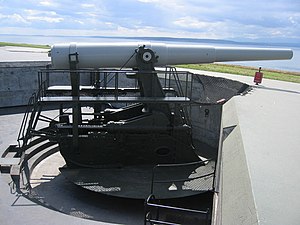10-inch gun M1888
| 10-inch Gun M1895 | |
|---|---|

10-inch gun M1895MI on disappearing carriage M1901, Fort Casey, Whidbey Island, Washington
|
|
| Type | Coastal artillery |
| Place of origin | United States |
| Service history | |
| In service | 1895–1945 |
| Used by |
|
| Wars | World War I, World War II |
| Production history | |
| Designer | Watervliet Arsenal |
| Designed | 1888 |
| Manufacturer | Watervliet Arsenal, Bethlehem Steel, possibly others |
| Variants | M1888, M1895, M1900 |
| Specifications | |
| Weight | 67,200 pounds (30,500 kg) (M1888MI and M1888MII) |
| Length | 30.6 feet (9.3 m) |
| Barrel length | 34 calibers 340 inches (8.6 m) |
|
|
|
| Shell | separate loading, 617 pounds (280 kg) AP shot & shell, 510 pounds (230 kg) HE |
| Caliber | 10 in (254 mm) |
| Breech | Interrupted screw, De Bange type |
| Carriage | M1893 barbette, M1894, M1896, or M1901 disappearing, most manufactured by Watertown Arsenal |
| Elevation | disappearing: 12° |
| Traverse | disappearing: 170° (varied with emplacement) |
| Maximum firing range | disappearing: 14,700 yards (13,400 m) |
| Feed system | hand |
The 10-inch Gun M1895 (254 mm) and its variants the M1888 and M1900 were large coastal artillery pieces installed to defend major American seaports between 1895 and 1945. For most of their history they were operated by the United States Army Coast Artillery Corps. Most were installed on disappearing carriages, with early installations on barbette mountings. All of the weapons not in the Philippines (except four guns in Canada) were scrapped during World War II. Two of the surviving weapons were relocated from the Philippines to Fort Casey in Washington state in the 1960s.
In 1885, William C. Endicott, President Grover Cleveland's Secretary of War, was tasked with creating the Board of Fortifications to review seacoast defenses. The findings of the board illustrated a grim picture of existing defenses in its 1886 report and recommended a massive $127 million construction program of breech-loading cannons, mortars, floating batteries, and submarine mines for some 29 locations on the US coastline. Most of the Board's recommendations were implemented. Coast Artillery fortifications built between 1885 and 1905 are often referred to as Endicott Period fortifications. The Watervliet Arsenal designed the gun and built the barrels. A few of the first guns were mounted on low-angle M1893 barbette carriages. Subsequently, most of the guns were mounted on M1894, M1896, or M1901 disappearing carriages; when the gun was fired, it dropped behind a concrete and/or earthen wall for protection from counter-battery fire.
...
Wikipedia
